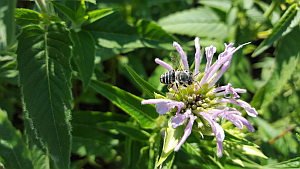Pollinator Protection at EPA
Over the past several years, the population of important pollinators has declined in the United States and internationally. Pollinators play a key role in agriculture, since the majority of native plants require pollination by bees or other pollinating animals.
To address the threat of diminishing pollinator populations, President Obama issued a memorandum establishing a Pollinator Task Force that developed the National Strategy to Promote the Health of Honey Bees and Other Pollinators. This strategy aims to reverse the declining pollinator populations through actions by federal departments and agencies.
 Leafcutter bee in the pollinator garden at EPA’s Research Triangle Park, North Carolina, campus
Leafcutter bee in the pollinator garden at EPA’s Research Triangle Park, North Carolina, campusEPA has launched a Pollinator Protection Initiative and is conducting pollinator site assessments to promote pollinator communities and habitats at its laboratories. In order to establish a comprehensive pollinator baseline, these site assessments:
- Inventory flora types
- Identify observed pollinator species
- Review landscaping practices
The pollinator baseline will be used to shape landscaping decisions that will protect and expand pollinator communities at EPA laboratories. For example, EPA’s campus in Research Triangle Park, North Carolina, has a pollinator garden and a number of different pollinator-friendly plants, shrubs, and trees that bloom throughout the year.
